Bourgoin is a peaceful town on the plain of the Nord Isère, halfway between Lyon and Grenoble. The full name since 1967 is Bourgoin-Jallieu, because, rather like the more famous Budapest (Buda and Pest), it is made up of two towns, which have spent much of their history merging and then separating.
The towns came together in 1654, but Jallieu took advantage of the French Revolution to secede in October 1791. Only quite recently, in 1967, did they join up again, so between the wars, Jallieu was an independent town.
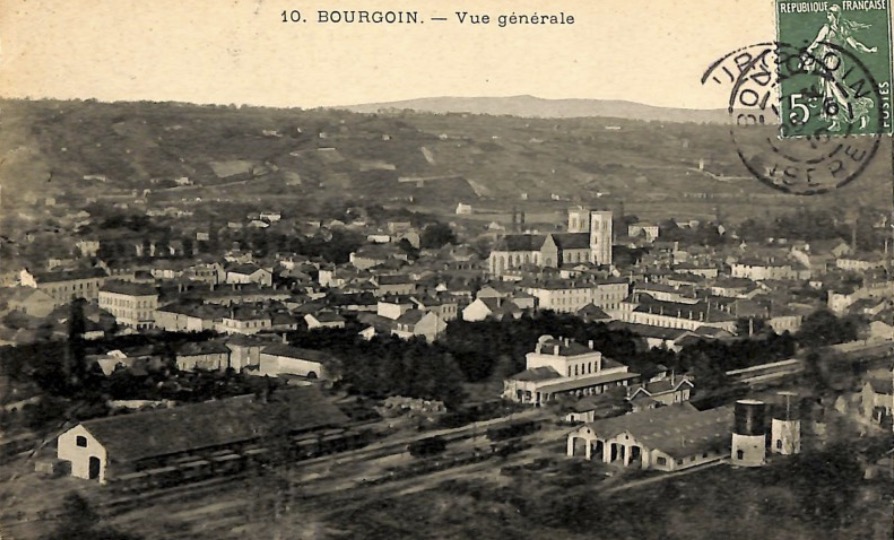
Geographically, Bourgoin and Jallieu occupy what was a strategic position on the former Roman road from Vienne (the town in the Isère not the city in Austria) to Aoste and Italy.
In the industrial era, the towns have been known for their textile industries. The railway arrived in 1858, but an urban bus network did not come on the scene until 1981.
The population figures are not quite reliable since Jallieu was independent during the years we are looking at, but available figures are for a combined Bourgoin-Jallieu and not just Bourgoin.
- 1921 6,162
- 1931 8,020
- 1946 7,699
The figure today is 29,160.
In the period under review, we must remember that inflation was rife. 100 francs in 1914 were worth 6 francs in 1938.
Regulation of routes did not exist in those days – coordination did become the rule in 1934, principally to protect the railways from competition from road passenger transport.
So where did the municipality of Bourgoin become involved? Firstly, it fixed the interurban bus stopping points on its territory, secondly it had a hand in subsidizing most routes bringing outlying villagers into town. There is nothing new about subsidies!
The first document, dated 27/01/1933, relates to the route of Autocars Argoud from Dolomieu to Lyon. Buses stop in Bourgoin at the café Guigne, place de la Halle and in neighbouring La Grive, café Simonet. These were the years when cafés were numerous and central to all village activity. The route also stopped at the café Gonnet in Mozas and the café Burdin in Jallieu!
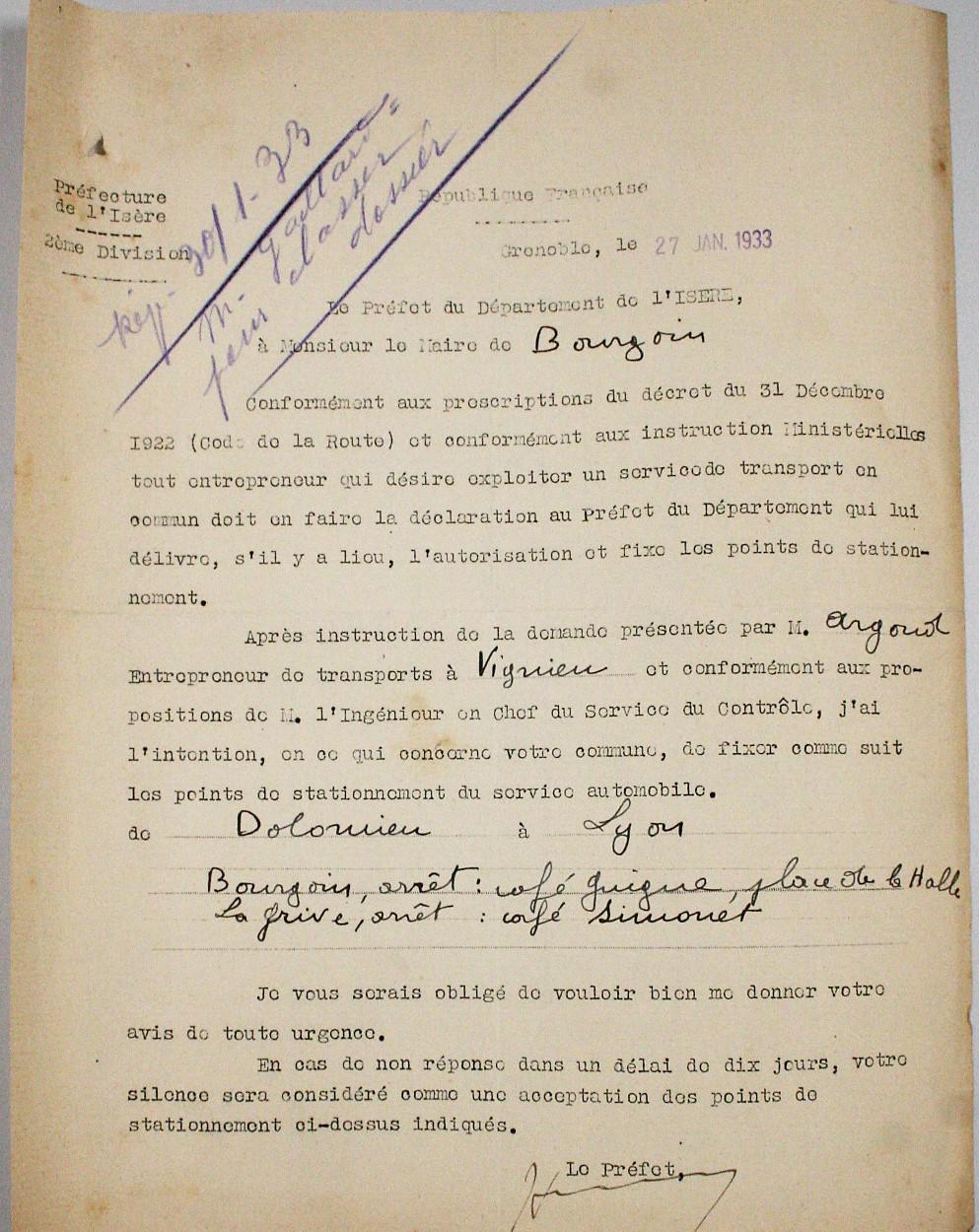
ARGOUD
More about Autocars Argoud can be found in the history of LES CARS DAUPHINOIS.
Another business that appears in LES CARS DAUPHINOIS is “La Novolaise’, operated by Marius Neyret on a route from Novolaise (Savoie) to Lyon via Pont de Beauvoisin. Marius’ widow sold the business in 1935, but as on 05/08/1932, the route was still stopping in 9 towns or villages in the Isère, 7 times at cafés and twice at Hotels!
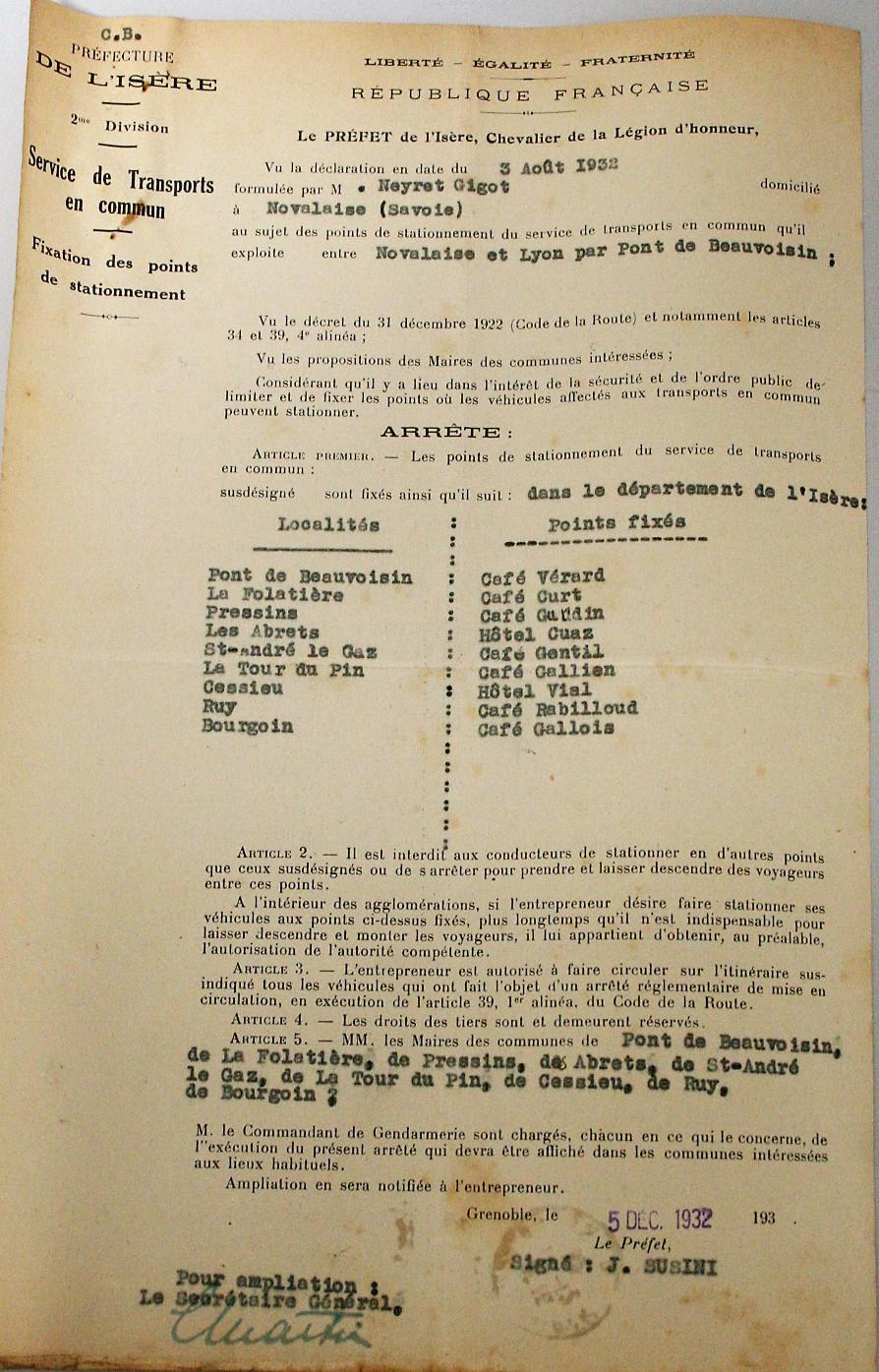
LA NOVOLAISE
We next have a series of three routes with stopping points fixed in 1932, fairly short local services which I have found nowhere else. No information has yet come to light as to when they started or how they ended.
Justin Chabert, of Chèzeneuve, ran from Chèzeneuve to Bourgoin railway station, a distance of 8 kms, via Maubec. In 2020, Chèzeneuve has no public transport.
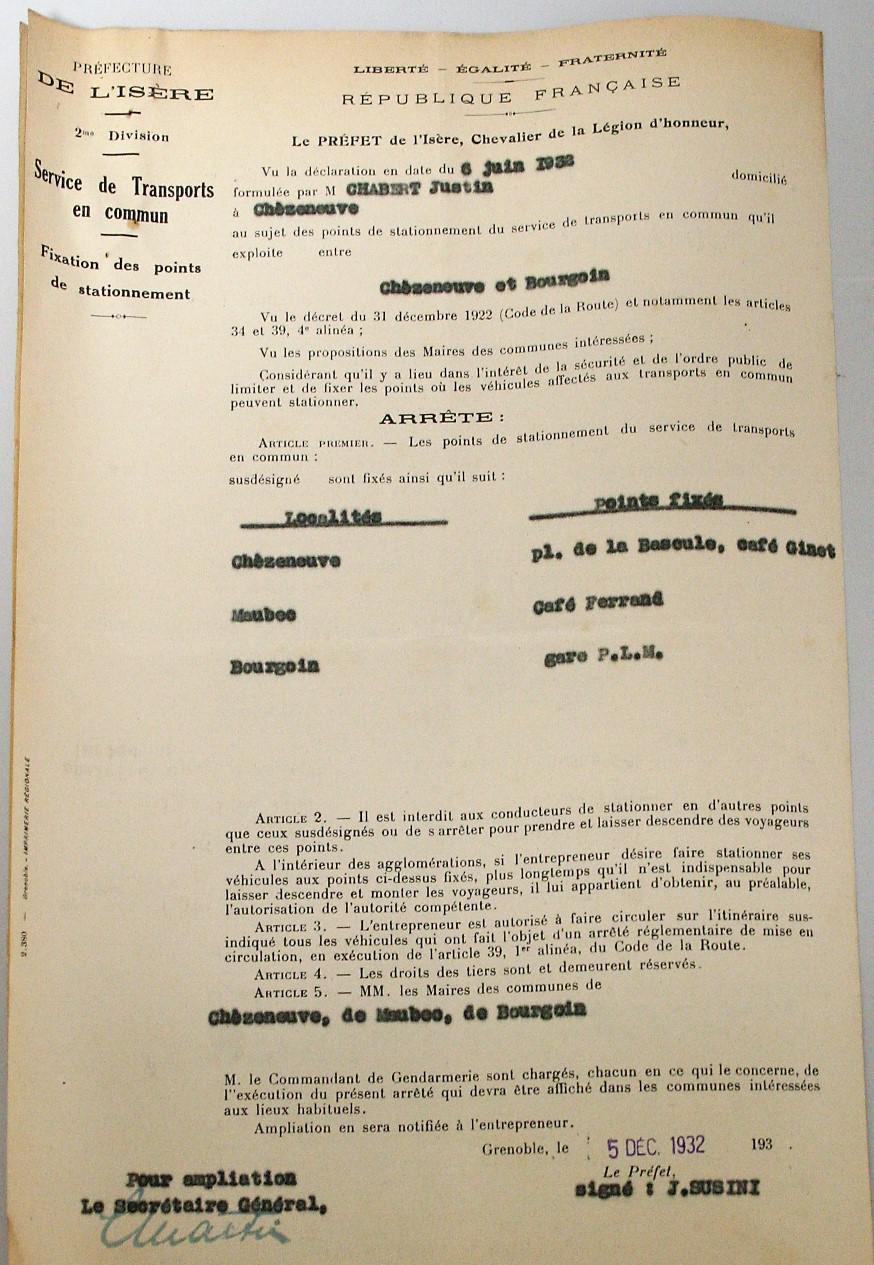
CHABERT
Paul Gentaz of Flachères ran from Flachères to Bourgoin, a distance of 15 kms, via the café Brun in Ecloses. In 2020, Ecloses is served by a demand responsive service.
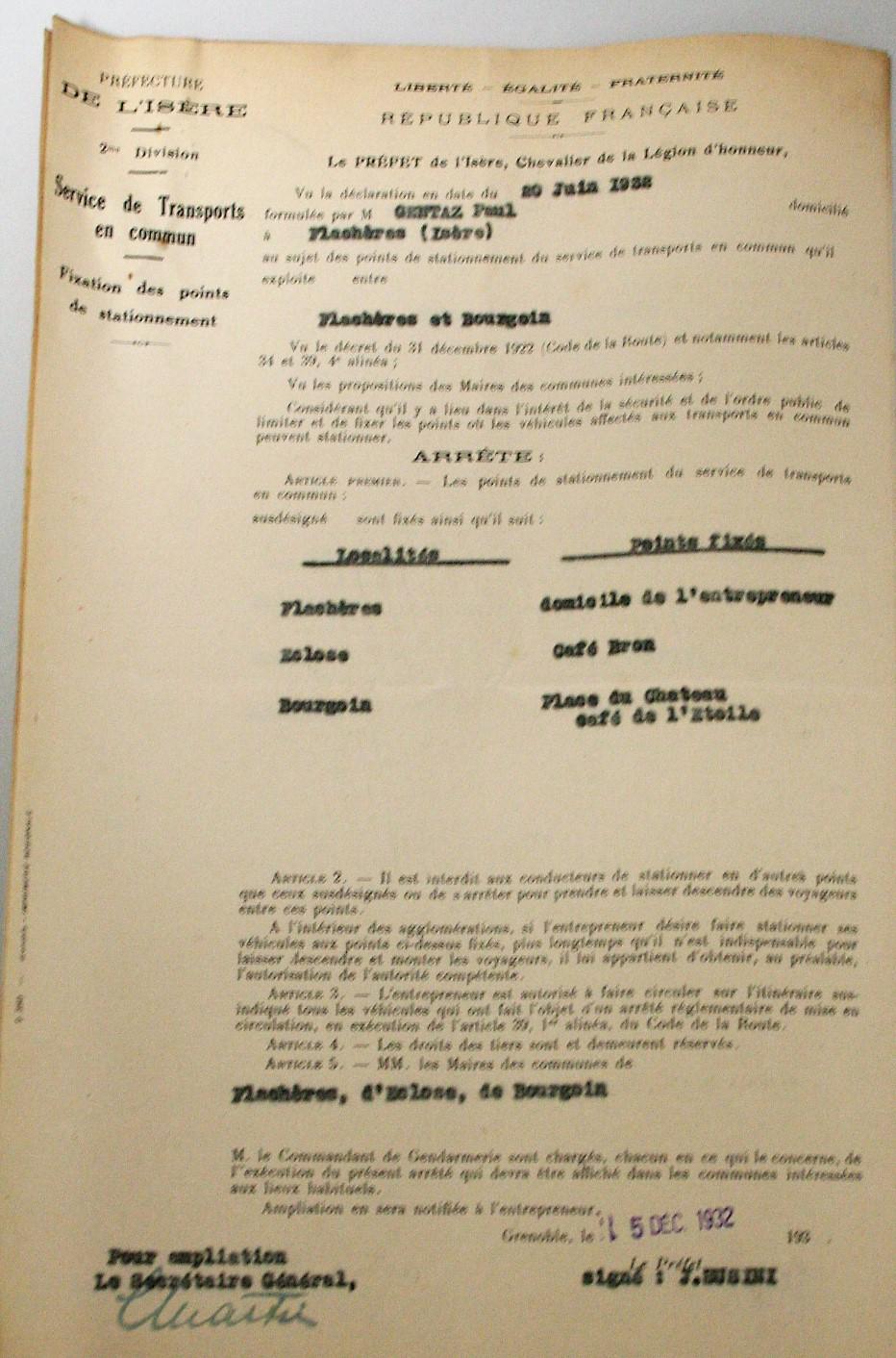
GENTAZ
And Auguste Fréchet of Monceau ran from Monceau to Bourgoin, a distance of 3 kms! But only on Thursdays and Saturdays, so it must have been a market service. In 2020 Ruy-Monceau is in the catchment area of Le Ruban, Bourgoin’s urban network.
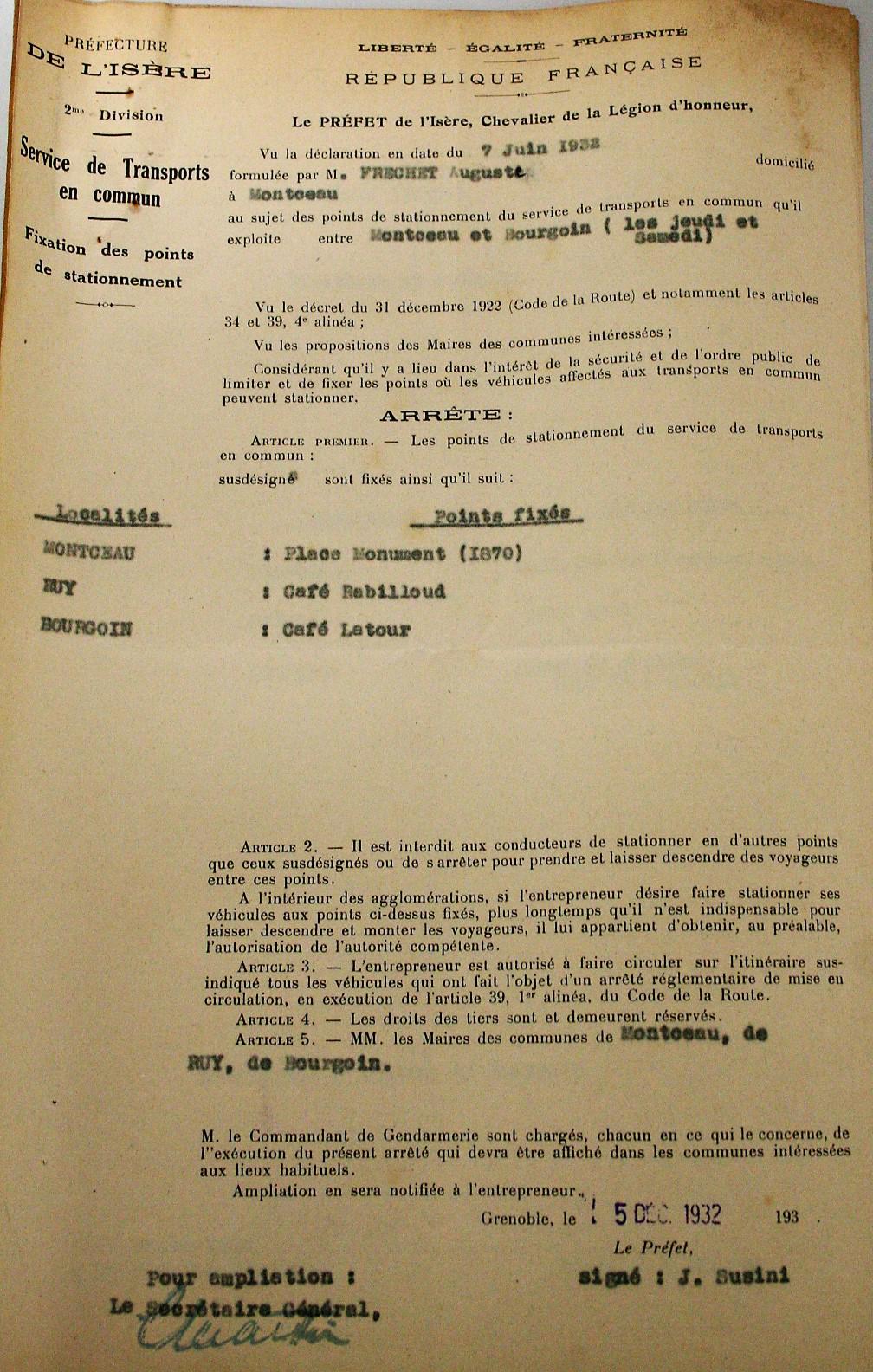
FRECHET
A slightly longer service – 23 kms – run by Moyne Berthon of Courtenay linked Courtenay to Bourgoin as at 16/02/1934. The terminus, place St Michel, is still a hub of the Bourgoin network in 2020. A member of the family still lives in Courtenay in 2020.
The final route we will look at is that from Lyon to Annecy, operated by Philibert & Girard, 32 rue de Marseille, Lyon, who are presumed to be the forerunners of the Philibert company now based in Caluire and one of the largest regional bus and coach companies. Until the 1970s, a significant number of operators ran routes from Chambery, Grenoble or Annecy to Lyon at a time when the motorway did not exist. The stops listed in the Isère, four in all, are not quite so cosy on this long distance route – “at the crossing of the roads”, at Les Abrets, seems capable of misinterpretation!
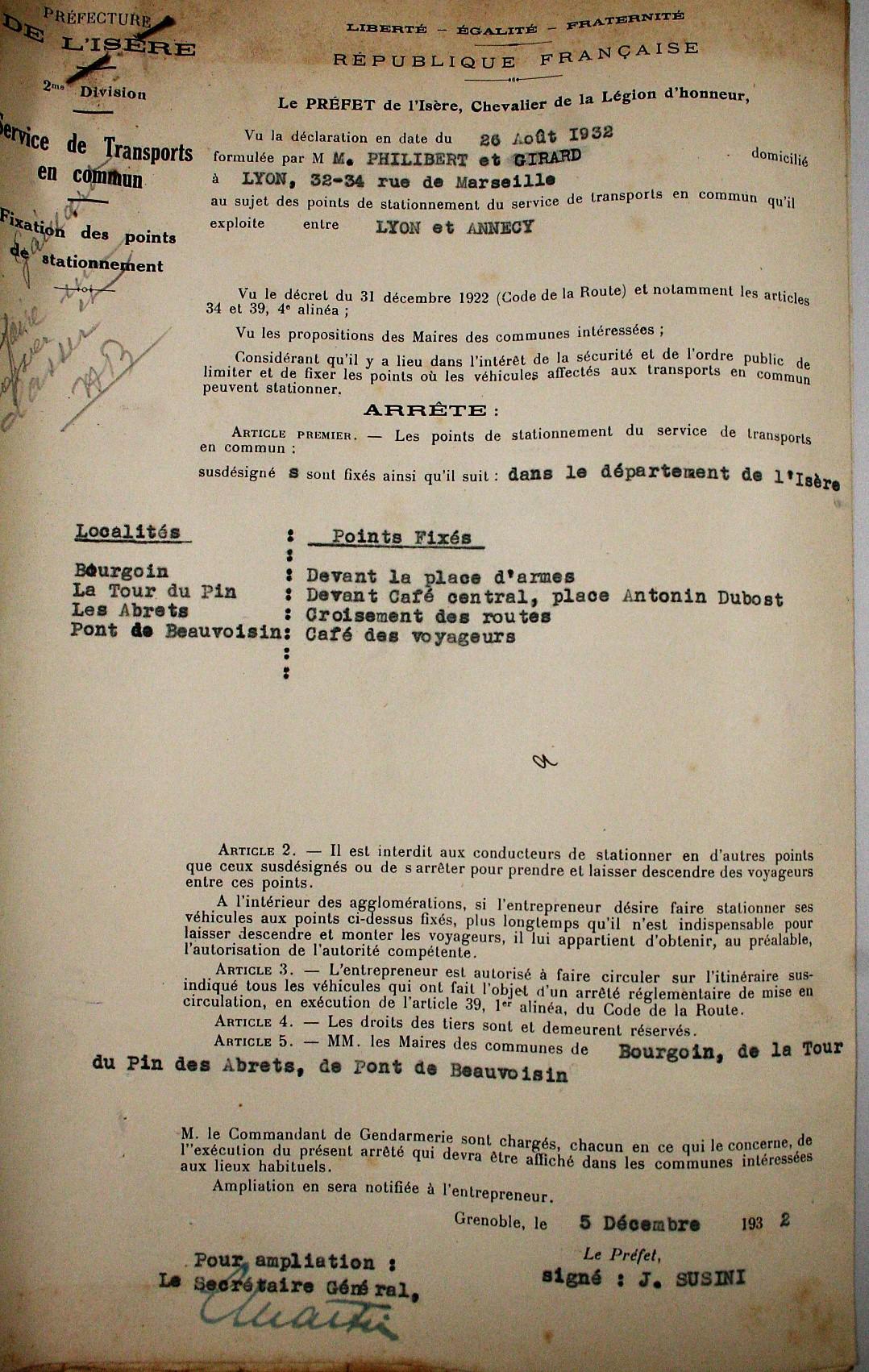
PHILIBERT and GIRARD
Subsidies for the route BOURGOIN – ST. CHEF – VIGNIEU
In May 1926, the Conseil Général fixed the annual subsidy for this service at 7,800 francs. This route was classified as a “service public automobile subventionné”.
On 25/07/1928, the subsidy was fixed at 15,000 francs, of which 5,175 francs was paid by the communes benefitting from the service, a sum reduced to 2,325 francs upon receipt of the State’s participation.
This calculation was the consequence of an Engineer’s report, of which a translation follows.
The bus service from Bourgoin to Vignieu via St. Chef was allocated a subsidy on 26 September 1926 by the Conseil General, on the basis of an annual maximum of 16,800 francs for three daily returns along the whole route.
However, the service put in place by Mr Boulud, a Bourgoin entrepreneur, consists of 3 journeys to St.Chef, but only 2 of them extended to Vignieu. This is why, at the last meeting of the municipal delegates, all the municipalities except Vignieu voted their agreed participations. Consequently, the full amount of subsidy not being voted, the Convention could not be signed, all the more so because the entrepreneur also refused a temporary increase in fares to bridge the gap until reception of just 2/3rds of the State aid allocated but not yet received. The route is currently operating with the commercial risk taken by the entrepreneur.
As we explained in our earlier report on the Bourgoin – Champier service, the entrepreneur, now he is again assured of receiving the full subsidy, requests that it should be paid to him again, subject to his applying the minimum fares fixed by Ministerial circular. But he still refuses, in spite of all our efforts, to extend the third daily journey to Vignieu. He accepts that instead, the subsidy be reduced from 16,800 to 15,000 francs.
When consulted, the mayor of Vignieu maintained the previous reservations of his council. He proposed that, if no sub-contractor could be found to operate the route according to the terms specified by the Conseil Général, then the 1,800 francs of subsidy be paid to Vignieu, which would use it to finance an alternative complementary service.
The municipality of Vignieu must nevertheless also pay its share of the municipal contribution, which, on the hypotheses envisaged, would be either 621 or 279 francs.
This way of proceeding does not seem acceptable to us. It seems logical that the route should be a single contract with a single common convention and terms of operation. We have nevertheless submitted the proposition to the administrative authorities for their opinion.
However, the circumstances are such that all municipalities except one are satisfied with the way it is currently organized and it has proved impossible to find another entrepreneur willing to accept the terms and conditions and to provide the extra service. We therefore consider the best solution to be that of agreeing to Mr Boulud’s proposal to reduce the subsidy to 15,000 francs.
The figures will therefore be:
1. Before State subsidy Département 65.5% = 9 825
Communes 34.5% = 5 175 TOTAL 15,000
2. After State subsidy State 38% = 5 700
Département 46.5% = 6 975
Communes 15.5% = 2 325 TOTAL 15,000
Each of the municipalities will contribute in the following proportions:
| Percentage % | Before state
contribution |
After state contribution | |
| Bourgoin | 21.3 |
1105 |
495 |
| Jallieu |
2.1 |
110 |
50 |
| St
Savin |
23.4 |
1210 |
540 |
| St
Chef |
25.5 |
1320 |
590 |
| Vignieu |
14.9 |
770 |
350 |
| Salagnon | 6.4 |
330 |
150 |
| Montcarra |
6.4 |
330 |
150 |
| 100 |
5175 |
2325 |
The Convention expired on 31/12/1937 but was extended to 01/05/1938 whilst awaiting the hypothetical changes engendered by the new coordination regulations. Then on 23/10/1938, the Conseil Général extended all its contracts of a temporary basis until 32/12/1938.
A much later item puts the route with Mr Joseph Demaille until 06/08/1931 when he sold the goodwill of Bourgoin – Vignieu to Mme Marie-Louise Besançon (wife of Joseph Joguet), domiciled in Montalieu (Isère). She then was granted the administrative concession of the route on 14/11/1939. There is more about that in the story of LES CARS DAUPHINOIS. Then on 21/02/1946, she was wanting to sell to two of her drivers; Marcel Sevoz, born at Pont de Beauvoisin on 08/03/1912, and Raymond Teillon, born on 19/06/2014 at St Chef. The outcome is not recorded.
Subsidies for the route BOURGOIN – CREMIEU
A subsidy was to be put in place in 1925, but the village of Frontonas was not in agreement with the amount requested. Below is the analysis of the Préfêt de l’Isère:
“On 12 June 1925, the municipality of Frontonas was called upon to contribute the sum of 150 francs of subsidy decided at a meeting of the mayors in the Town Hall at Bourgoin on 28 May. Frontonas refused to contribute anything to this service, unless the itinerary was changed so that the route would be of some use to its inhabitants.
Frontonas was not present at the mayoral reunion on 28 May which allocated the contributions totaling 1,837 francs as follows.
- Frontonas 150 fr
- L-Isle d’Abeau 200
- St Marcel Bel Accueil 250
- Panossas 200
- Veyssilieu 100
- Chozeau 200
- Villemoirieu 100
- Jallieu 150
- Crémieu 230
- Bourgoin 257
- TOTAL 1,837
It is clear that the contribution demanded of Frontonas is excessive in view of the minimal usefulness of the route, as the intended itinerary only passes through the hamlet of Massonas.
A new meeting, chaired by Mr Giraud (Conseiller Général), was held on 2 July, and a new calculation of contributions was voted by the mayors present. The municipality of Veyssilieu, absent on 28 May, and which had been allocated 100 francs to pay, saw its contribution reduced since the route did not serve the village at all. It was not represented at this meeting on 2 July either, but the contribution was reduced to 25 francs, with a proviso that if it refused to pay that sum, the other municipalities would have their contributions increased instead.
The mayors decided not to change the proposed itinerary, since the modifications proposed by Frontonas would lengthen the journey by 4 or 5 kms and reduce the usefulness of the service for the other municipalities.”
In agreement with the Ingénieur en Chef du Controle, the new contributions voted were:
- Bourgoin 287 fr
- Jallieu 150
- L’Isle d’Abeau 225
- Frontonas 50
- St Marcel Bel Accueil 250
- Panossas 250
- Veyssilieu 25
- Chozeau 250
- Villemoirieu 100
- Crémieu 250
- TOTAL 1,837
Exactly why is not clear, but in 1926 the state subsidy was reduced from 56% to 44%.The shortfall had to be made up by the communes (1/4) and the département (3/4). So the 1 837 francs became 2 100 francs.
By July 1928 and presumably with inflation, the global Conseil General subsidy of 15 000 francs was to be increased to 22 000 francs. The municipalities were to pay 7 590 francs of that to begin with, reduced to 3 410 francs once the increase was voted.
Subsequently, terms and conditions were signed on 08/09/1930, and the convention expired on 08/08/1935, but must have been extended since the route was one of those that the Conseil General extended again on 23/10/1938 until 31/12/1938.
But who was running the service? We have to go back to the beginning and the Engineer of the Ponts et Chaussées to find out.
The bus service to connect Crémieu with Bourgoin received approval for a subsidy from the Conseil Général on 30 May 1925, and at the same time the CG submitted an application to the state for a state subsidy. The total annual amount was fixed at 15,000 francs. A Bourgoin entrepreneur, Mr Boulud, agreed to the terms and conditions, and a convention was drawn up and signed by him and by the authorities.
By the time Mr Boulud began operating in 1926, the cost of supplies and raw materials had risen to such an extent that fares had to be increased. At the same time the state advised that it would not have the funds available to pay its part of the subsidy until 1927.
As a consequence of a blanket decision by the Conseil Général dating from5 May 1925, only 2/3rds of the state’s unpaid subsidy could be recovered through an additional increase in fares. In spite of the increase, the entrepreneur was out of pocket, and quickly abandoned the service without it being possible to impose sanctions of any kind.
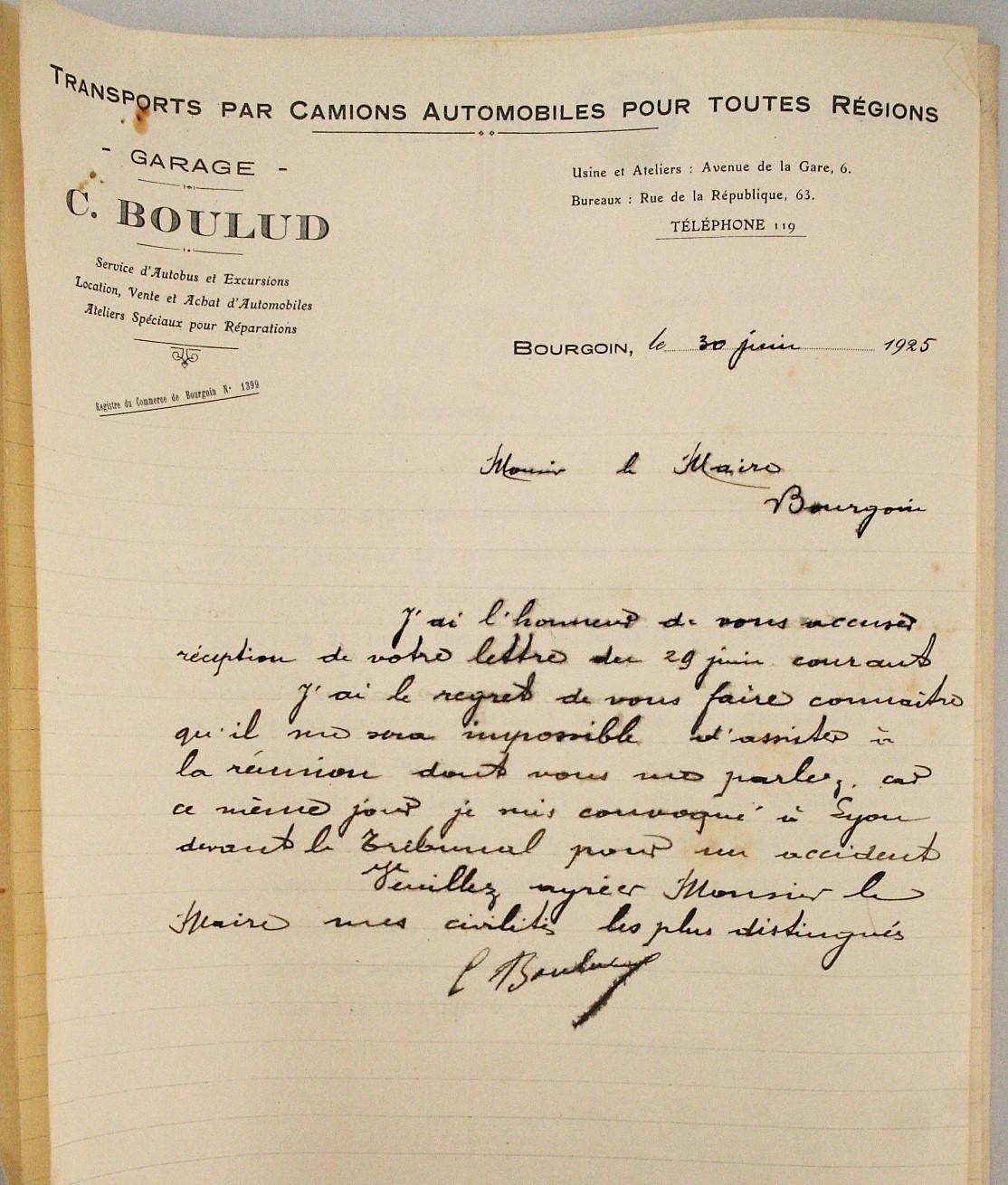
Mr Boulud’s notepaper – a letter
of June 1925
In 1927, an effort was made by a new entrepreneur – VACHER-SOUCHON. This lasted from 4 August until 7 November 1927, when he too threw in the towel on a loss-making service.
Mr Vacher – Souchon wrote to the mayor of Bourgoin on 18 August 1927.
“It is now exactly 2 weeks since the new bus service from Cremieu to Bourgoin started operating with the punctuality that I promised and according to the timetable that I submitted to you. Even on the bank holiday (15 August) I transported to Bourgoin or to Crémieu all the travellers going to or from the intervening localities.
But the success is such that the vehicle with which I began the service has proved to be insufficient on busy days – Wednesdays, Thursdays, Saturdays, Sundays and even Mondays. So, with the same speed of decision-making that I showed in starting up in 8 days a service which specialists said could not be done without numerous trials, authorisations etc etc etc, I have decided to purchase a second vehicle, a little larger, which will replace or accompany the first one according to needs.
But all that has a cost that has to be financed. I will not hide from you the fact that the costs are highest at the beginning – insurance, road tax, stationery, posters, timetables, tickets etc etc Consequently I wish to remind you of your promise to advance part of the subsidy to cover the first month of operation.”
The reply is not recorded.
But back to the Engineer.
“From then on, the Bourgoin – Cremieu service ceased running for lack of an operator. But a ministerial decision on fares, together with a change of policy by the Conseil Général, increased the minimum fares significantly. They became:
- Passengers 0.30 per km
- Packets (Messageries) 7.00 per tonne
- Goods (Marchandise) 2.50 per tonne
As for the state subsidy, it was fixed at 38%. In spite of the uncertainty as to whether that sum would effectively be paid, the operator received the whole subsidy fixed by the terms and conditions of his contract, and the municipalities became obliged to ratify two possibilities – one amount to be paid before receipt of the state subsidy, and a reduced payment afterwards. In the first case, the combined municipalities paid a subsidy of 34.5%, in the second case 15.5%.
When they heard of these new measures, a number of entrepreneurs expressed renewed interest in operating the service under the new rules. Two applications were made. One was by the former operator, Mr Boulud, but on the basis of a fixed subsidy of 22,000 fr and not 15,000 fr. The second was by a Mr Girard of Crémieu, who would probably insist on the same conditions. Both applications were based on the minimum fares described above, and with a route frequency the same as before.
The earlier subsidy of 15,000 fr in 1925 was the equivalent of 610 fr per route kilometer, too low now, and experience had shown that the route could only subsist with a higher level of subsidy.
The sum of 22,000 fr is the equivalent of 895 fr per route kilometer, justified by the fact that a certain number of similar services were receiving subsidies in the region of 1,000 fr per route km.
The new figures should be put before the Conseil Général as soon as the municipalities have voted their contributions;
Before state subsidy Département 65.5% - 14 410
Municipalities 34.5% - 7 590 “
Sadly, it is not stated who won the contract.
We have met Mr Boulud at Vignieu and at Crémieu, but in 1925 he also operated from Bourgoin to Vienne. He was losing money on that route, and sold the Vienne – Heyrieux section to Mr Faure ( now Cars Faure).
He also ran from Bourgoin to Roche on market days – Thursdays.
The archives contain some older documents.
Bourgoin – Artas: On 26/10/1922 the 1922 subsidy was increased from 675 fr to 745 fr. Artas is 15 kms from Bourgoin on the road to St Jean de Bournay. No other information has come to light on this route.
Bourgoin to Vézeronce via Jallieu, Flozailles and St. Chef: On 06/05/1918, Mr Geneste, mayor of Vignieu, subsidized this route to the extent of 150 fr with imposed stops at Gare de l’Est de Lyon and Place St. Michel in Bourgoin. On 27/04/1922 the itinerary was changed to serve Vasselin and the 1923 subsidy became 450 fr.
Bourgoin – St Jean de Bournay: For 1913/1914 the Conseil General subsidy was 400 fr per km, not exceeding 7,040 fr in total. Bourgoin voted an additional 324 fr in 1913 increased to 330 fr in 1914.
Bourgoin – Morestel: Below is a handwritten note. The Conseil General, on 28/09/1911, agreed a subsidy of 10,000 Fr subject to the municipalities providing 1/8th of this -1,250 fr. The list of contributions is included, and it is noted that Mr Geneste, mayor of Vignieu, at a meeting on 31/05/1912 at St Chef, pledged a personal participation of 165 fr provided that St Chef agreed his choice of route between St Chef and Vignieu.
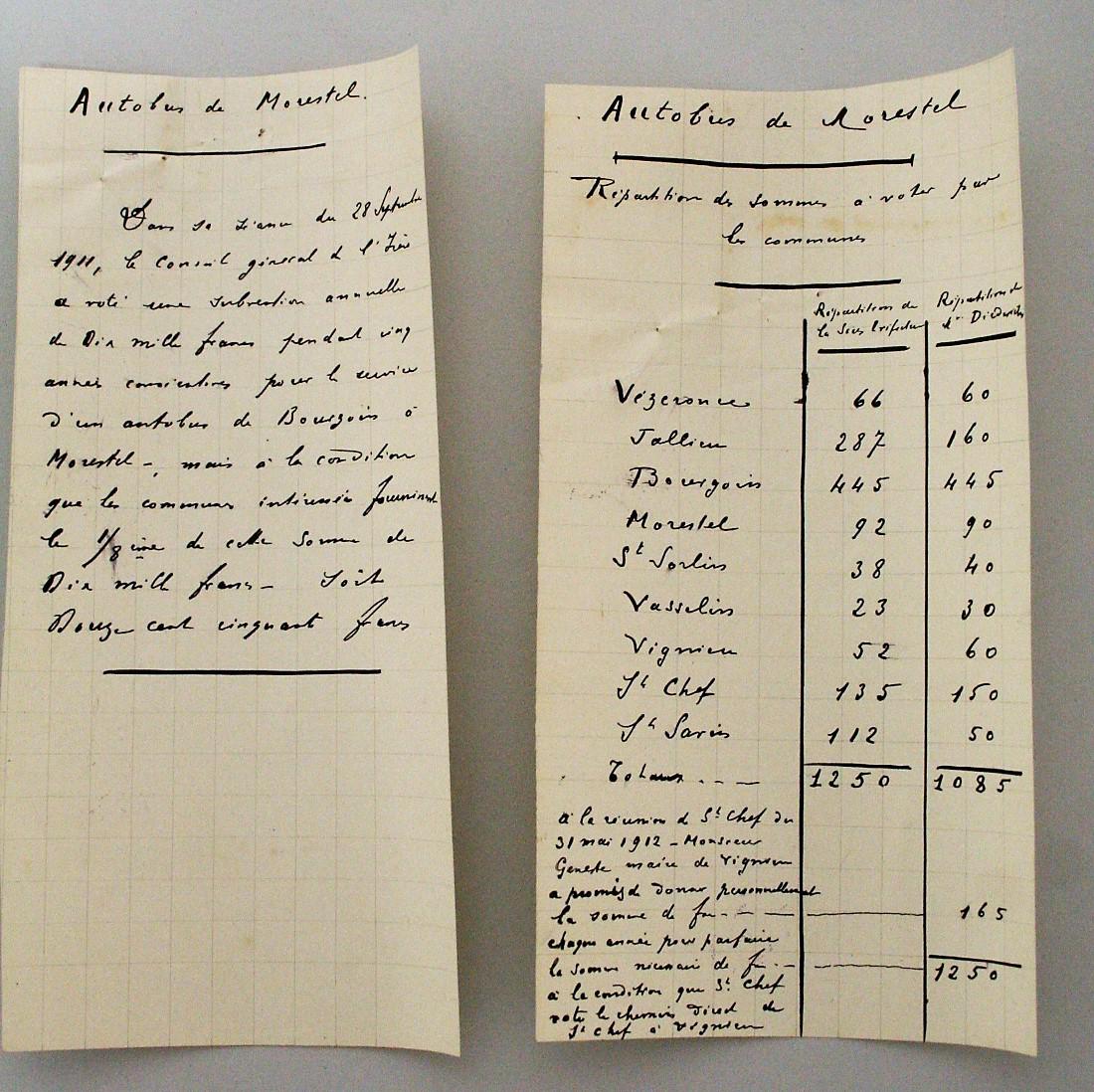
We will end with a tongue in the cheek item.
On 19/11/32, a petition was circulated by the Association of Owners of Establishments wanting to ensure that Town Centre termini remain unchanged – ie café and hotel owners.
“travelers have no reason to use buses if the terminus of the route is banished to the outskirts of the town” – this was following on Lyon’s efforts to create hubs at Vaise, Perrache, Croix-Rousse and Brotteaux.
There is nothing new under the sun!
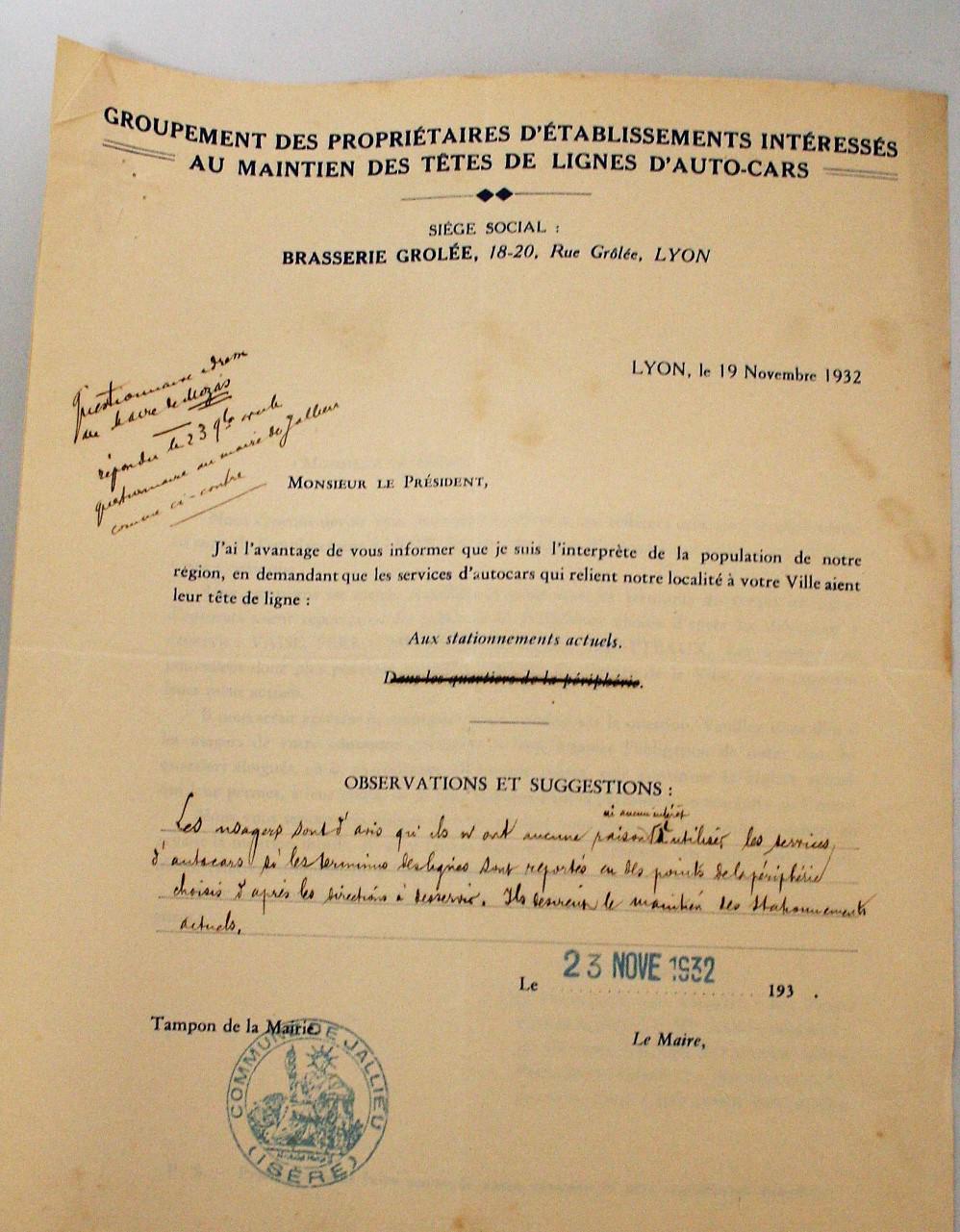
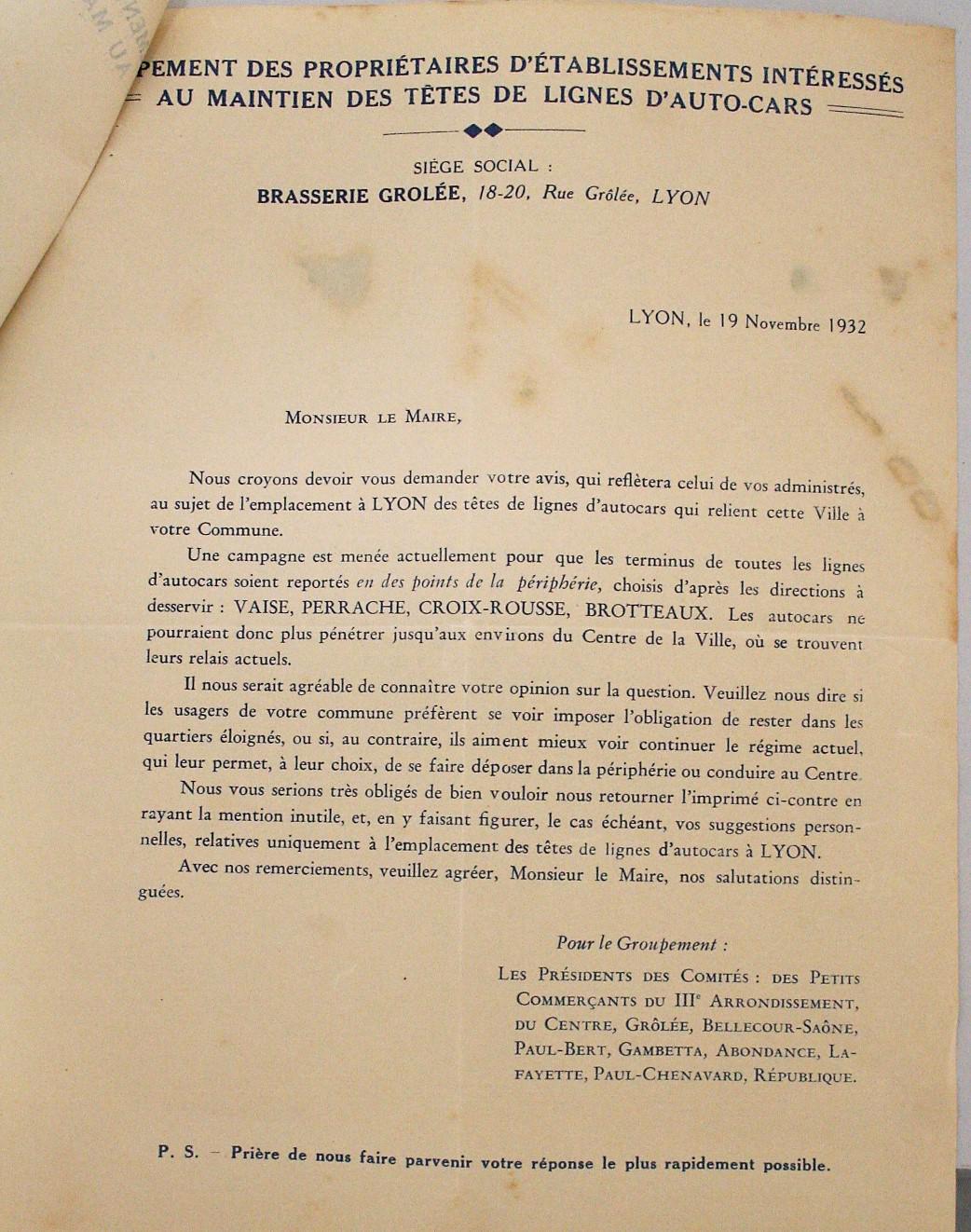
C. R. D’EATH -
15/09/2020
Note
- this is a site of historical record and does not contain
current service information
Nota - Il s'agit d'un site d'archives historiques et ne contient pas de données actuelles
Nota - Il s'agit d'un site d'archives historiques et ne contient pas de données actuelles
| DORSET
(RURAL) |
DORSET (URBAN) | SOMERSET |
WILTSHIRE |
HAMPSHIRE |
| FAROE ISLANDS | FRANCE (NATIONAL) | FRANCE (REGIONAL) | ISLE
OF SKYE |
LINCOLNSHIRE |